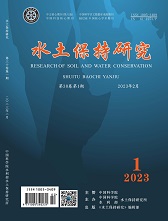[1]LI Zai-ming.The Estimation of Minimum Flow in Streams of Taiwan——A Case Study of Eastern Taiwan[J].Research of Soil and Water Conservation,2001,8(04):146-150.
Copy
The Estimation of Minimum Flow in Streams of Taiwan——A Case Study of Eastern Taiwan
Research of Soil and Water Conservation[ISSN 1005-3409/CN 61-1272/P] Volume:
8
Number of periods:
2001年04期
Page number:
146-150
Column:
Public date:
1900-01-01
- Title:
- The Estimation of Minimum Flow in Streams of Taiwan——A Case Study of Eastern Taiwan
- Keywords:
- Taiwan; streams; minimum flow
- CLC:
- P332.3
- DOI:
- -
- Abstract:
- The flow assessment methods have been extensively discussed but have no real resolution. Minimum flow in rivers and steams provides a certain level of protection for the aquatic ecosystem. Therefore, the estimation of minimum flows becomes one of the major considerations in dam construction. Three major categories of quantitative instream flow assessment methods, including historic flow, hydraulic geometry, and habitat have been examined last decade. Historic flow and hydraulic geometry methods are used in this study to estimate the minimum flow in the upstream of Hoping Stream. The historic flow methods rely on the recorded or estimated flow of the river. Tennant method, flow duration curve and the watershed area estimation are the most widely known methods. The estimations of the minimum flows are 1.46 cms in the flooding season and 0.61 cms in the dry season. The results based on the daily flow duration curve are 3.12 cms to 1.87 cms while the exceeding probability from 96%to 100%. According to the watershed areas versus flow experience value estimation method, the estimations of the minimum flows are 0.95 cms and 1.06 cms by using different parameters. Hydraulic geometry methods based on various parameters such as width, depth, velocity, and wetted perimeter. The estimation of this study is from 3 to 2 cms in different parameters. Habitat methods are not examined in this study due to the complicated procedure to establish the habitat suitable curves.
- References:
-
[1] Jowett, I.G.Instream flow methods: A comparsion of apptoach[J].Regul.Rivers:Res.Mgmt.1997,13,115~127.
[2] Karim, K., M.E.Gubbels, & G.Goulter.Review of determination of instream flow requirements with special application to Australia[J].Water Resources Bulletin,1995,31(6):1 063~1 077.
[3] Karr, J.R., P.R.Yant, & K.D.Fausch.Spatial and temporal variability of the index of biotic integrity in three midwestern streams[J].Trans.Am.Fish.Soc., 1987,116,1~11.
[4] Lorenz, C.M., G.M.Van Dijk, A.G.M.Van Hattum, & W.P.Cofino.Concep ts in river ecology: Implications for indicator development[J].Regul.Rivers: Res.Mgmt.1997,13,501~516.
[5] Montgomery, D.R.& J.M.Buffington.Channel-reach morphology in mountain drainage basins[J].GSA Bulletin,1997,109(5):596~611.
[6] 吴富春,李国升.河川栖地模式PHABSIM之水理计算敏感度分析[J].台湾水利,1998,46(2):60~70.
[7] 李载鸣.台湾地区重要河川鱼道设计之研究[Z].文化大学土地资源学系,1996.
[8] 徐荣秀,管立豪,潘彦宏,等.森林溪流淡水鱼类保育工作资料汇整[Z].溪流环境保育研讨会讲义,1997.101~113.
[9] 曾晴贤.鲤鱼潭水库士林水力发电工程士林坝下游河道最小生态维护放水量检讨工作.中兴工程顾问公司,1995.
[10] 谢国正、吴素祯,谁是最后之赢家-台湾鱼类vs.水利工程师[J].中兴工程,1995(45).134~139.
[11] 顾培森.高山地区防砂坝与生态维护[C].第一届治山防洪研讨会论文集,1995,115~144.
- Similar References:
Memo
-
Last Update:
1900-01-01
